If you’re planning a trip to Japan on a budget, we’ve got you covered with tons of money-saving tips that’ll cut costs on everything from accommodation to entertainment. Plus we’ve included a list of free things to do in Japan that won’t cost a thing!
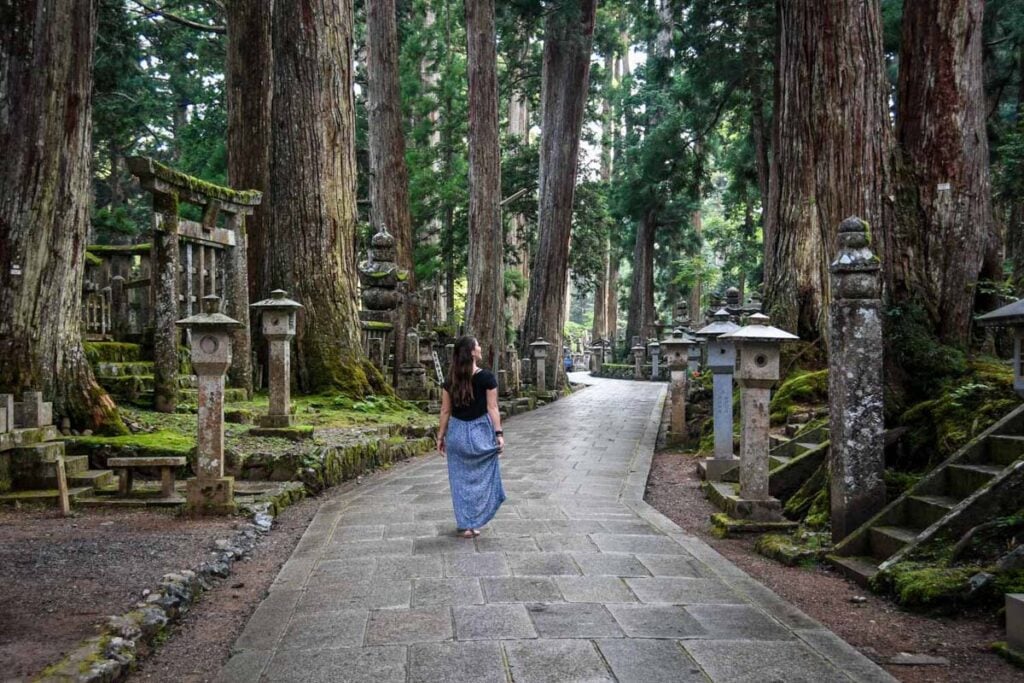
Japan is a notoriously pricey destination.
When you break down the cost of a trip to Japan, there’s no getting around it: Japan is expensive. However, there are ways to travel to Japan on a budget if you know what you’re doing.
We’ve personally traveled to Japan several times, and have rounded up our best money-saving tips so you can travel to Japan without breaking the bank!
Japan on a Budget Guide
- Top money-saving tips
- Tips for saving money on transportation
- Tips for saving money on food
- Tips for saving money on accommodation
- Tips for saving money on entertainment
- Free (& cheap) things to do in Japan
Japan on a budget: Top money-saving tips
If you’re looking for our top money-saving tips for traveling Japan on a budget, here they are!
- Travel during low season to get the best rates on accommodation.
- Buy a Japan Rail Pass if you plan to visit several places during your trip.
- This article breaks down how much the Japan Rail Pass costs and how to purchase it.
- Get your breakfasts and snacks at 7-Eleven or Family Mart (they are everywhere around the country!). While you might never consider eating at a convenience store in your home country, the fresh food options are surprisingly good at these stores in Japan. I’m not joking. You’ll see many locals doing the same.
- Have your biggest meal midday and take advantage of “lunch sets” which often consist of a large meal (sometimes with a dessert) and are typically very affordable.
- Conveyor belt sushi is a good way to try all the types of sushi your little heart (and stomach!) desire without a huge price tag. Plus, it’s a fun experience in itself!
- Use an app to record your spending and see how well you’re staying on top of your budget! We find it’s much easier to overspend when you don’t know how much it’s all adding up to.
- Download a converter app on your phone like this one to see the exact exchange rate for your selected currency at the time of your trip, so you always know exactly what you are spending.
- Withdraw yen from the ATM using a card that reimburses all ATM fees (like the Charles Schwab debit card).
Keep reading for more tips on how to save money on different aspects of traveling in Japan…
General tips for saving money in Japan
Let’s start with some of the general money-saving tips that will help you keep your budget under control.
1. Travel during low season
Hotel rates vary a lot with demand, so traveling during peak tourist season (especially “Golden Week”) means you’ll pay a heck of a lot more than during less busy times of the year.
To save a lot of money overall, plan your trip for shoulder or off-peak season (ex. we loved visiting Japan in the winter because it was far less expensive and busy). During low seasons, you may be able to score a deal on accommodation.
- High season: mid-March – May (cherry blossom season), summer months
- Low season: late November – March (except around New Years holiday)
Related: Read more about Japan’s seasons and the best time of year to go!
2. Withdraw yen from the ATM
Instead of getting a bunch of yen at your home bank or using currency exchange counters, head straight to the ATM when you land in Japan.
ATMs give you the best exchange rate. Plus, if you use a card that reimburses all ATM fees (like the Charles Schwab debit card), you won’t pay anything for this exchange.
This is how we always get local currency. We haven’t done it any other way in 10+ years of travel.
3. Understand the conversion rate
Download a converter app on your phone like this one to see the exact exchange rate for Japanese yen at the time of your trip, so you always know exactly what you are spending.
It can be easy to spend more than you’d like if you don’t know the exchange rate for yen.
4. Keep your spending in check
We recommend coming up with a budget before your trip so you don’t accidentally overspend.
Psst! We recorded all sorts of average costs in Japan so you can get a really great idea of how much to budget.
While on your trip, use an app to record your spending and see how well you’re staying on top of your budget! We find it’s much easier to overspend when you don’t know how much it’s all adding up to.
5. Score a cheap flight
Sign up for a mistake fare newsletter, like Thrifty Traveler, so you can get alerted when there are really good deals on flights from your home airport to Japan.
Keeping an eye on the flight prices will help you understand what’s an average flight and what’s a good deal.
Flying to Japan is a long haul for many travelers coming from Europe or North America. This makes it a good opportunity to use airline points to pay for some or all of your tickets.
6. Book early
Japan is a destination that we’d recommend booking earlier than you typically would for other trips.
When you book earlier, you’ll have a better selection of accommodations to choose from, making it easier to get a good deal.
There are also certain activities that must be booked in advance and you won’t want to miss out.
We created a Japan booking timeline that should help!
7. Pack right
Put some extra thought into what you pack. While there are many things you can easily get once you get to Japan if you forget them, there are certain items that are very hard to come by. And if you do find them, they can be quite expensive.
Some examples of items that are hard to find or expensive in Japan:
- Menstrual products
- Deodorant
- Sunscreen
- Shoes or clothes in larger sizes
Save yourself the time, hassle, and money by checking out our Japan packing list so you don’t forget any essentials and make a costly mistake!
Tips for saving money on transportation in Japan
There are some really great money-saving options for transportation in Japan if you know what you’re looking for. We’re going over a handful of different options that will save you money on transportation in Japan:
8. Get the Japan Rail Pass (maybe…)
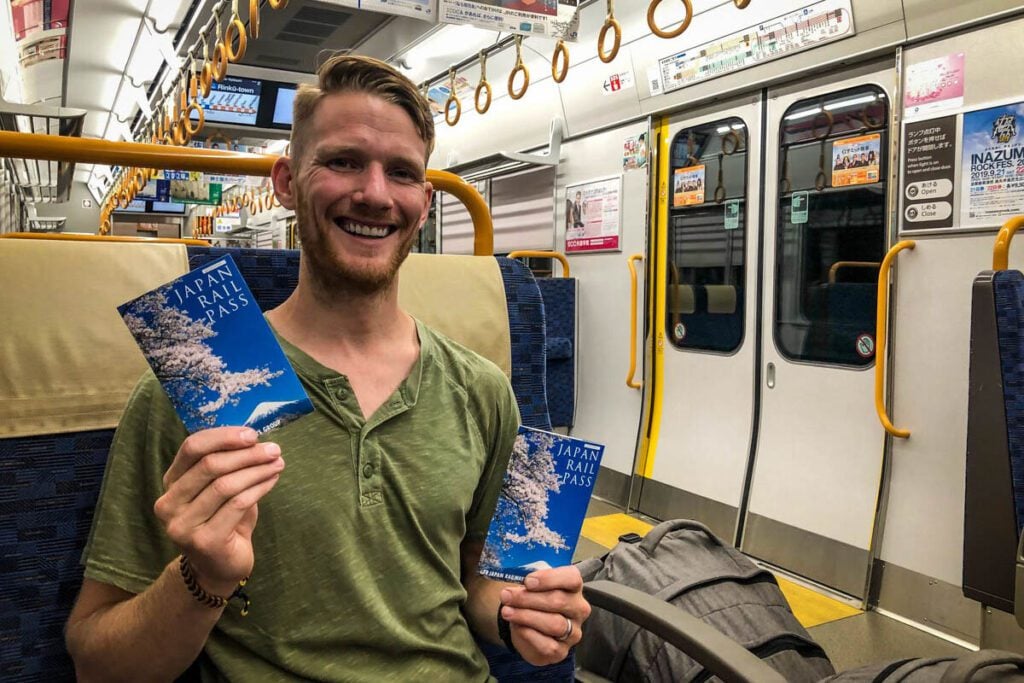
It is a train pass only available to foreign tourists in Japan.
It allows you to ride specific trains for one bundled price instead of paying for each ticket.
Is the JR Pass worth the money?
This is a tricky question to answer… In the past, I would have said 100% YES. It was a huge cost savings.
However, there was a pretty major price increase to this super discounted pass in late 2023. This means that it won’t be as big of a cost savings as it used to be.
Depending on your itinerary, it may not even make sense to purchase the JRail Pass… Alternatively, it could still save you a bunch of money. You’ll need to do some calculations to figure out if it makes sense.
Don’t worry – we’ve gotchu!
We put together a guide that walks you through how to decide if this pass is a good purchase for your trip or not.
We don’t want you to spend unnecessary money, so be sure you read this thoroughly in order to make the best decision for you.

9. Compare trains with other modes of transportation

Depending on your itinerary, it might actually make more financial sense to rent a car or to take a domestic flight.
Due to the price increase on train tickets, these other modes of transportation can actually be cheaper, depending on where you’re going.
Psst! We’ve got an entire guide to renting a car in Japan (we did a 15-day car rental and absolutely loved it!). Our guide breaks down all the costs involved with renting a car and goes over some essential driving tips.
10. Look into tourist transportation passes
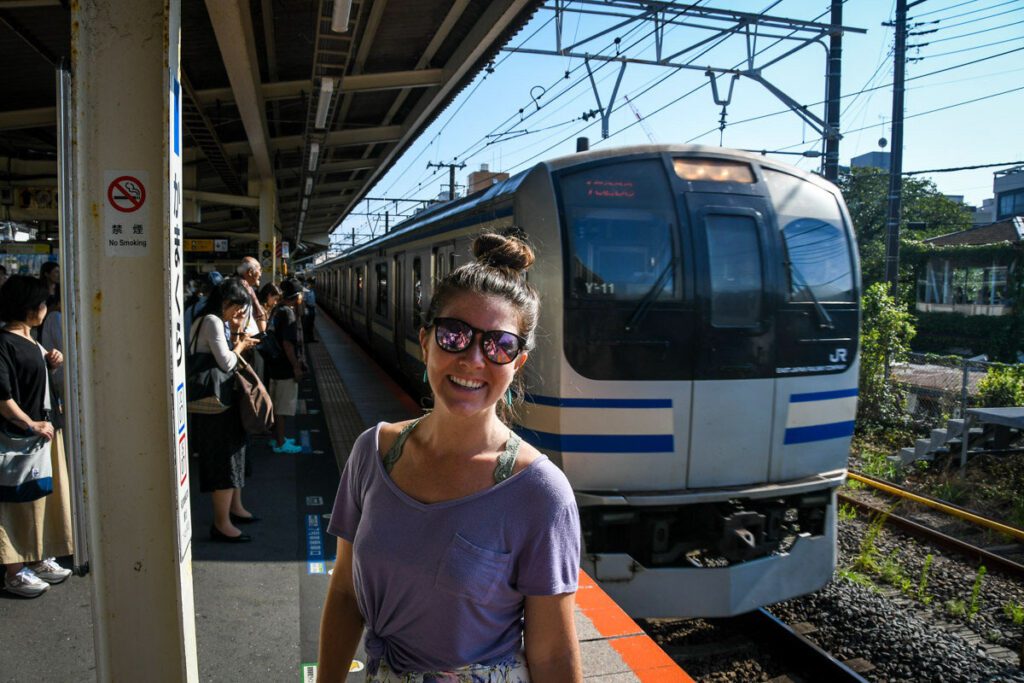
Many places in Japan are not connected with JR lines or metro systems. Instead, there are sometimes regional tourist passes available.
This will be a “bundle” pass which generally includes different modes of transportation, like rides on regional buses, cable cars or a funicular.
If you’re traveling outside of major cities in Japan (and you should!) check to see if that region has a tourist pass.
Here two examples of bundles that can potentially save you money:
- Hakone: This small mountain town known for onsen and views of Mount Fuji can be reached by JR trains, but once you’re there, getting around the area is not covered. Instead, most tourists buy the Hakone FreePass, which includes all bus, boat, and cable car transportation in the area.
- Koyasan: This area known for Buddhist temple stays and stunning Okunoin Cemetery cannot be accessed with JR trains. The Koyasan World Heritage Ticket is what most visitors use for this area.
Tips for saving money on food in Japan
This is one of the areas you can really save on if you are traveling Japan on a budget. We’re going over a handful of different options that will save you money on food in Japan:
11. Order “breakfast sets” from coffee shops
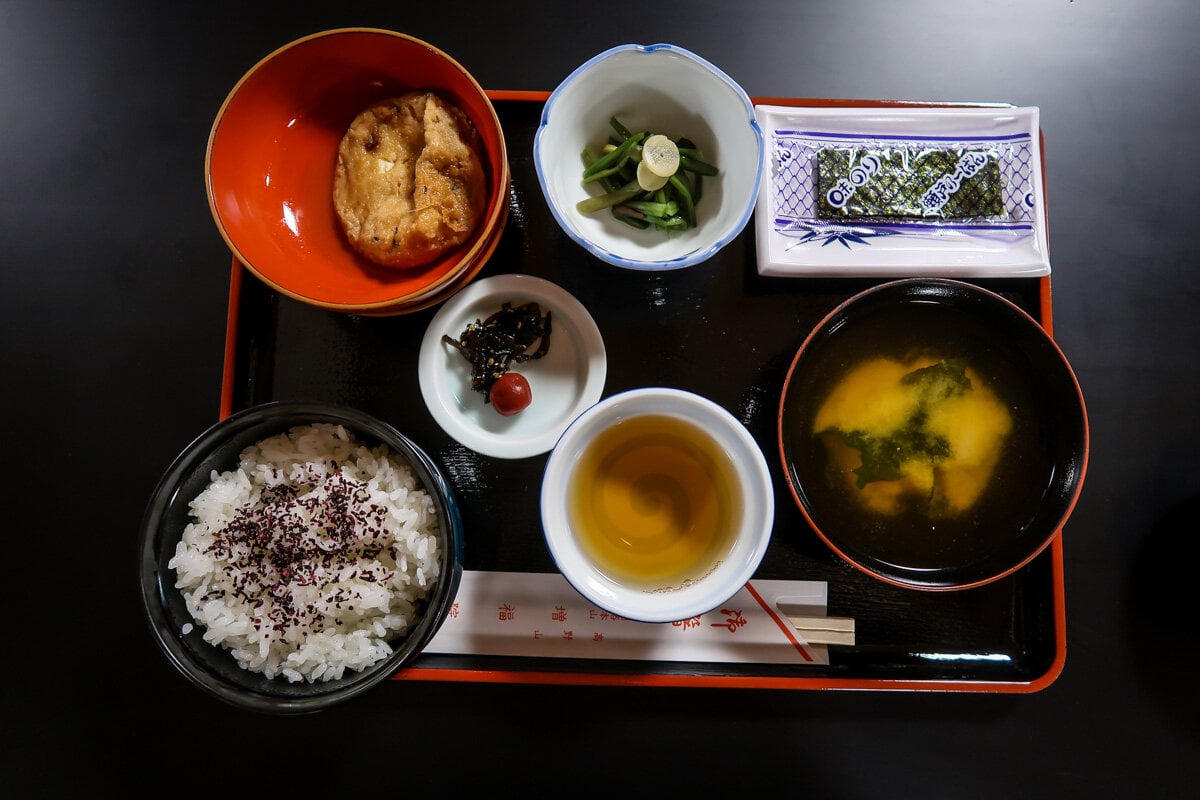
I love breakfast. Give me a smoothie or scrambled eggs and I’m one happy lady. But in Asia, breakfast is just different.
Rice and soup are common breakfast items, and there just really aren’t many breakfast restaurants. For that reason, many hotels catering to Western tourists will have an option to add on breakfast, typically for $10 – 15 USD.
If budget is a constraint, skip this and instead, head to a nearby chain coffee shop where “breakfast sets” can be a pretty good deal.
You’ll select a breakfast option, like an egg sandwich, croque monsieur, or a pastry, as well as coffee or tea. Together, the meal and the drink will come to around 400 – 600 yen.
Common coffee shop chains in Japan that offer “morning sets” are Doutor, Caffe Veloce, St. Marc, and Pronto.
Alternative: Another option is to grab something at a convenience store, like a pastry item and iced coffee.
12. Have your biggest meal at lunch
Restaurants in Japan often have “lunch specials” where they serve a similar meal to what you’d get at dinner, but for a cheaper price.
13. Eat meals at convenience stores
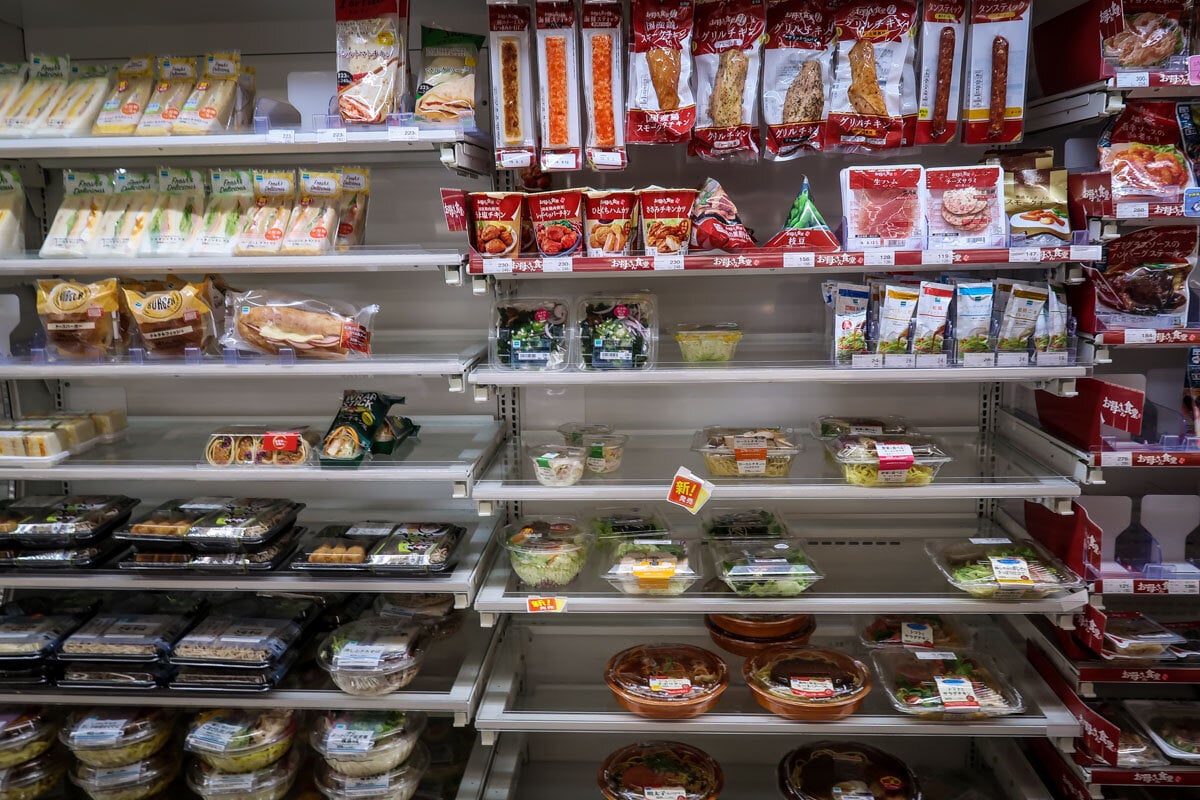
If you’ve been researching Japan, you’ve probably heard a bit about the convenience store culture. You’ll be able to find marts (konbini) on just about every block (sometimes multiple on a block), and entire meal options inside.
Many Japanese businessmen and businesswomen rely on these meals for quick lunches and dinners, and you’ll find options like fresh noodle dishes, dumplings, sushi, rice bowls, meat cutlets, and pasta that can all be heated up by the cashier if needed.
Additionally, you’ll find desserts, pastries, chips, and other snacks, just like any convenience store.
Sometimes I hear travelers talk about how they are only going to eat at 7-Eleven during their trip to Japan to keep costs down; but I think this is a mistake for two reasons:
- Trust me when I say you’ll want something other than super processed foods for every meal. Yes, there are many options at the convenience stores, but finding actually healthy options is challenging, to say the least.
- You’ll want to have some splurge-worthy meals! Unless you’re really not into food, you’ll definitely want to explore Japanese cuisine outside of 7-Eleven. There are so many incredible places to eat in Japan, and it would be a shame to not try any of the cuisine outside of convenience stores.
Moral of the story: Plan to balance your cheap meals with some splurge-worthy ones to have a balanced food budget.
14. Book accommodation with a kitchen
We booked a handful of accommodation options with kitchens, which really helped us keep our food costs down.
Many hostels have kitchens, as do some of the budget-minded guesthouses. Sometimes hostel kitchens are gross and have minimal equipment, but in Japan we found all the kitchens to be really well-stocked and clean!
Tip: Convenience stores usually have a section with frozen vegetables and other meals, which is a good place to look if you want a cheap and easy dinner.
15. Get cheap sushi
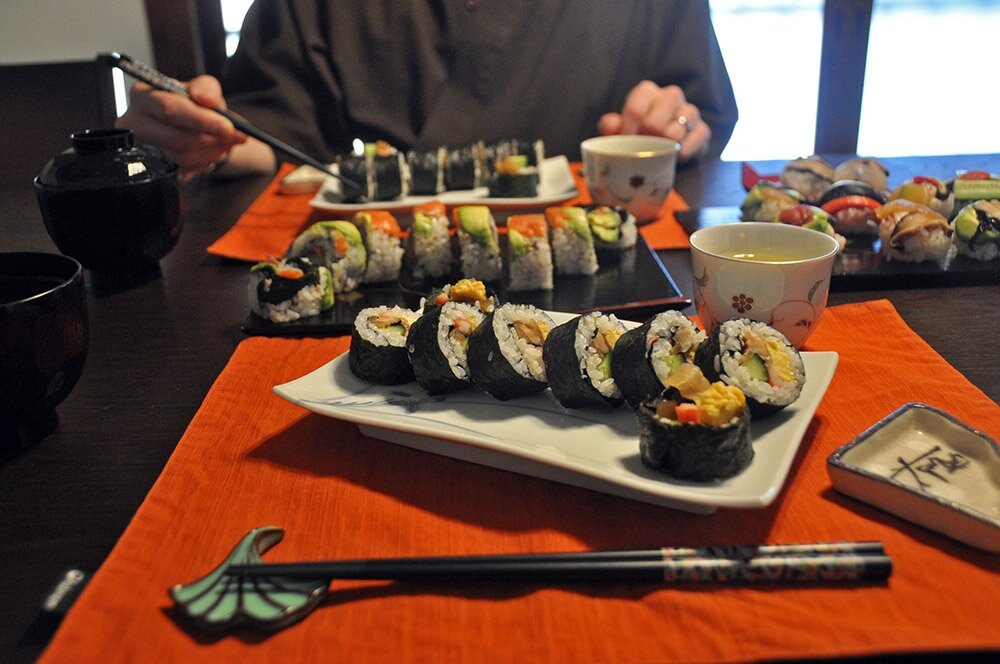
If you’re a sushi-lover, you’re definitely going to want to go to the famous fish markets and order a set at least once. This will set you back a cool $40 USD (if not more!), but it’ll be worth it for some of the freshest fish in the world.
That said, it’s not possible for most of us budget travelers to do this more than a couple of times. So if the sushi craving strikes again during your trip, consider some cheaper alternatives.
Conveyor belt sushi is popular with locals and it allows you to try many different types while keeping the cost down.
Another surprising option is getting sushi at convenience stores. I would never recommend doing this in say, the United States, but in Japan, it’s far less sketchy than it sounds. Japanese people do this all the time, and the quality is actually very good for the price you pay.
16. Eat less fruit
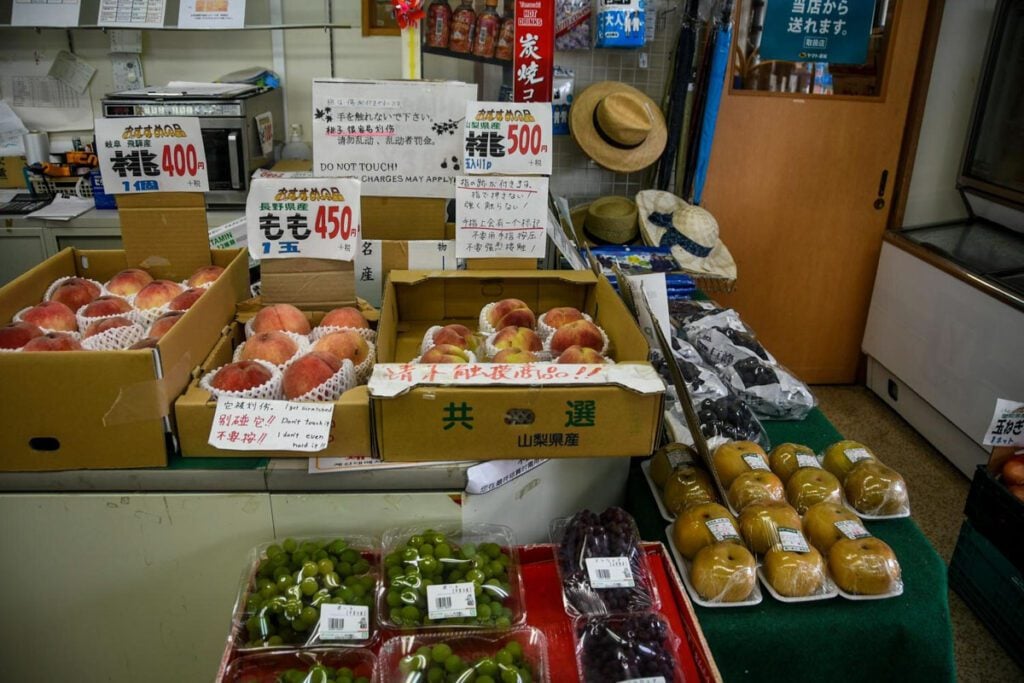
I’m about to drop a bad news bomb: Fruit is generally pretty expensive in Japan.
Think $3 – $4 for a single peach and $1 for a single (plastic-wrapped) banana…
It’s fine every once in a while when the craving strikes, but if fresh fruit is a daily habit, it’s gonna add up.
Interesting Tip: We found that some local fish markets had fruit stands, and the prices were the cheapest we found anywhere. Also, keep your eyes peeled for small roadside stands next to farms. We found a few of these selling fruits and veggies for reasonable rates.
17. Pack your own snacks from home
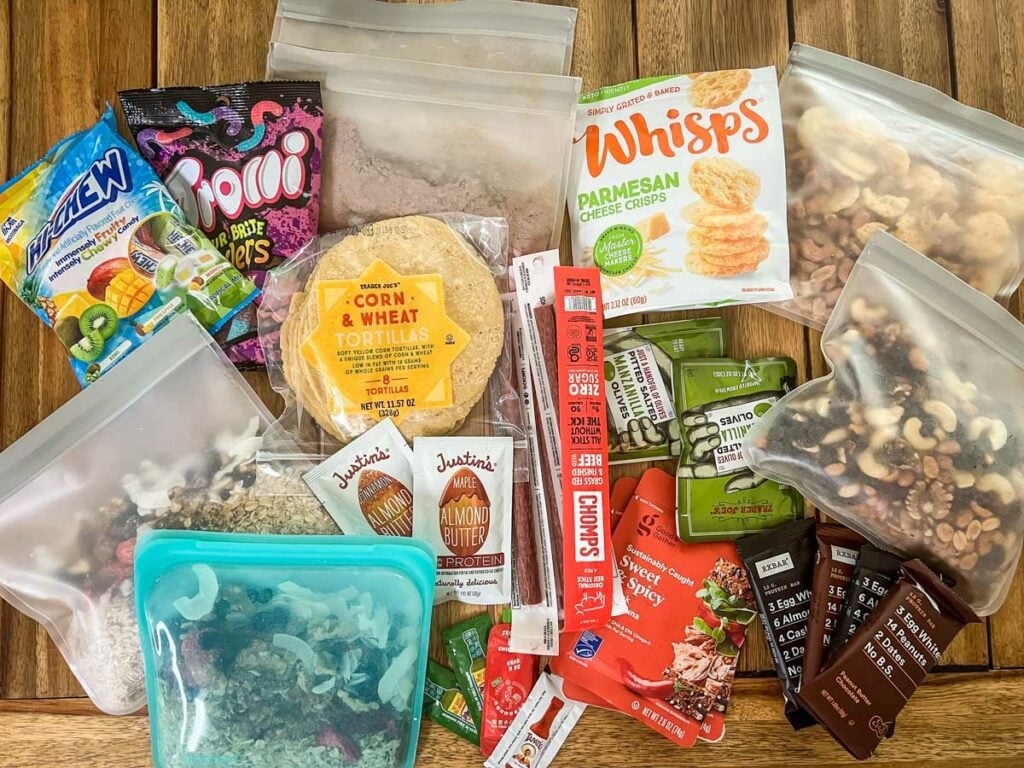
If you’re flying to Japan from your home country, consider packing some snacks like protein or granola bars, trail mix, and dried fruits.
You can find some of these things in Japan (with a lot of searching), but they tend to be quite expensive or come with added sugar, which we’re not huge fans of.
Having these handy will help keep your snacking costs down, and will help you avoid the “but I’m so hungry I just need something” splurges (we’ve all been there). And most importantly (in my opinion), it’ll keep you feeling healthy during your trip.
18. BYO Coffee
If you love to start your morning with coffee, you may want to consider bringing your own. Most hotels in Japan do not have coffee makers, like you might be used to in other parts of the world.
We packed our travel Aeropress and were so happy we did. We could enjoy our morning coffee without having to seek out a coffee shop (many of which actually open quite late!) and we saved a lot of money by not buying daily Americanos!
19. Don’t tip
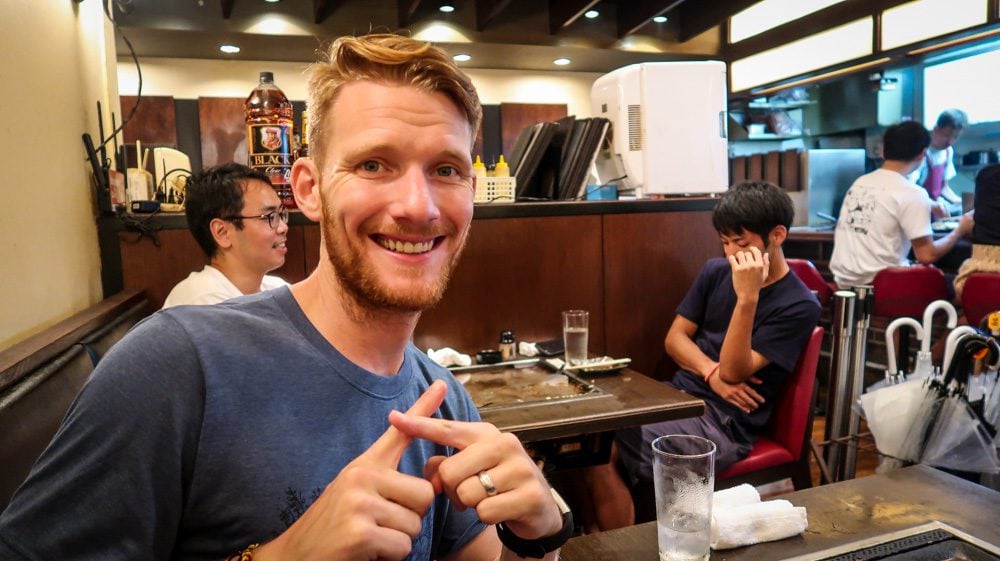
You won’t have to account for tipping in your budgeting because it is not customary in Japanese culture, and in some cases it can even be seen as slightly offensive.
20. Fill up with tap water
The tap water in Japan is safe to drink, so fill up instead of buying bottled water.
Not only will this help lessen plastic waste, but you’ll also save money.
Tips for saving money on accommodation in Japan
Accommodation is arguably going to be one of your biggest expenses when traveling in Japan. Below are some tips that will save you money on accommodation in Japan.
21. Know where to look for budget accommodations
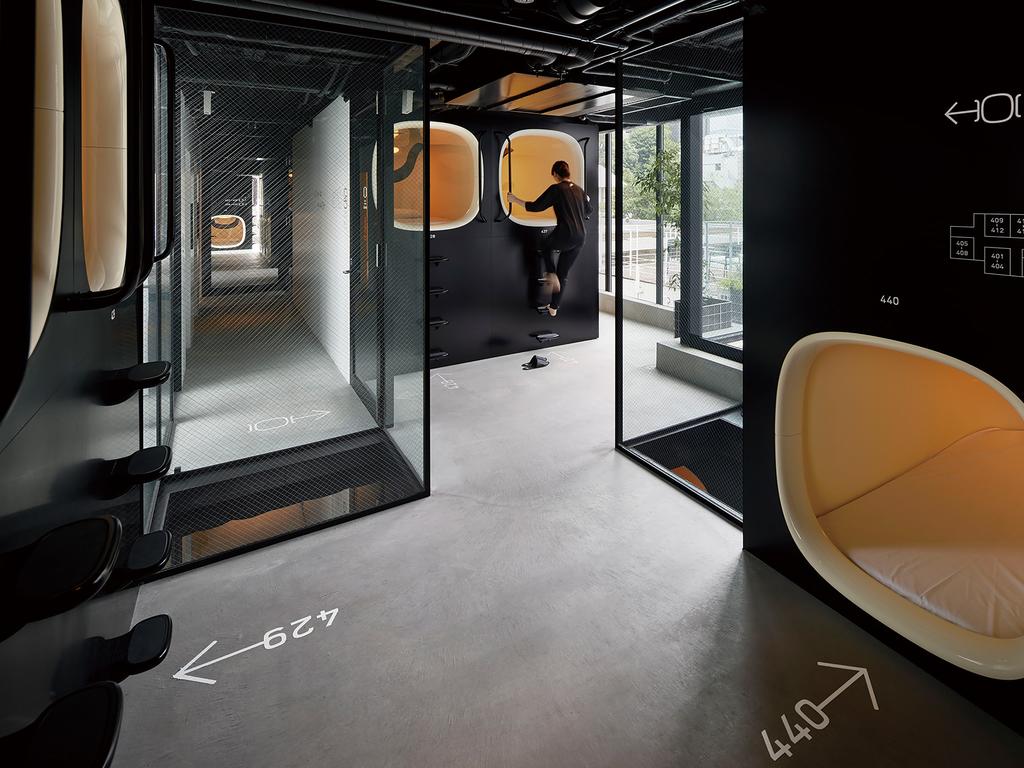
The following types of accommodation are good options for those on a tight budget:
- Hostels: No matter where you’re traveling, hostels are the most affordable option, and Japan is no different. The hostels we’ve stayed at in Japan tend to have large dorm rooms instead of small dorms or private rooms.
- That said, they had a pretty high standard of cleanliness and each dorm bed had privacy curtains. One thing to note is that we found hostels in Japan to be less friendly/communal than most other places in the world. That could have just been our personal experience though.
- Capsule hotels: These pods are similar to dorms in a way, but each capsule is larger and more roomy than a dorm bed. There are also usually some additional amenities like public baths and pajamas, which hostels don’t offer. Nicer capsule hotels can get to be a bit expensive in Japan, but you can find very basic ones as well.
- Staying in a capsule hotel is just one of those “Japanese experiences” you should have at least once on your trip!
- Airbnb: It’s a good idea to check Airbnb to see if there are any listings that fit your budget, as they can be more affordable than traditional hotels.
- Bonus: Check out our tips for booking the best Airbnb!
→ Related: Find out our genius system for finding the best accommodation every time.
22. Book your hotel like a pro
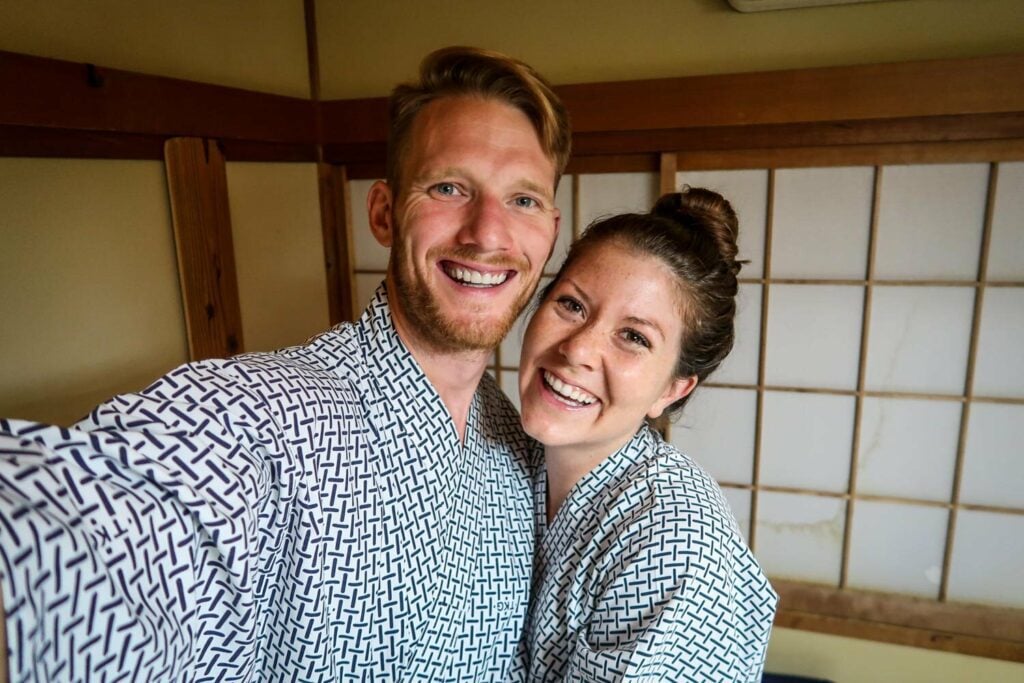
Here are a couple of tips that will help you when booking hotels in Japan:
- We like looking at Booking.com and Agoda in order to compare prices. Typically, they’re similar, but there have been times where one booking platform has a significantly cheaper price.
- You may also want to compare these platforms with booking directly through the hotel, as this is more common in Japan than in many other countries. Sometimes the hotel’s rate is cheaper. Other times it is the same and booking through them is cumbersome to navigate.
- When booking, we like to use all the filters to our advantage. With Booking.com for example, there are tons of different options to click on the left side of the page. That way in a city with tons of options, like Tokyo or Osaka, you can narrow it down to a hotel that is perfectly suited to you. Select your budget, preferred neighborhood, guest rating, type of room, breakfast preference, etc.
- When possible choose hotels with free cancellation. Booking.com often offers this up until a few days before your arrival. This can make it easier to secure a great price when you see it because there isn’t a risk of losing money if you change your plans.
23. Consider Couchsurfing, House Sitting or WorkAway
If you’re on a super tight budget and have some flexibility in your timing (lucky you!), you might want to consider Couchsurfing or WorkAway opportunities.
Couchsurfing: Stay in a local’s home for free! Couchsurfing is more than just a free place to crash; it’s an opportunity to connect with a local and see their home country through their eyes.
Oftentimes accommodation on Couchsurfing will be outside the city center so be sure you know how you’ll get around. Also, many hosts require guests to stay a certain number of days so they don’t get people only interested in a free bed.
House Sitting: Truthfully, there aren’t a ton of house sitting options in Japan, however, it’s worth a shot if you have really flexible dates.
WorkAway: Volunteer your time in exchange for room and board. Many places require that you stay at least a week (or sometimes even two!), so you’ll need to have a flexible schedule. This can be a great way to see a different side of Japan than you’d see otherwise. Just be sure to read reviews before you make a commitment.
Here are some opportunities that look pretty cool:
- Volunteer on an organic farm.
- Here’s another organic farm opportunity, just for good measure!
- Work at a B&B near a ski resort.
- Volunteer on a bee farm.
- Help in an art village.
And those are just a handful!
Tips for saving money on entertainment in Japan
There are some really great budget options for entertainment in Japan if you know where to look. Below are our top tips that will save you money on entertainment in Japan:
24. Find free (and cheap!) things to do
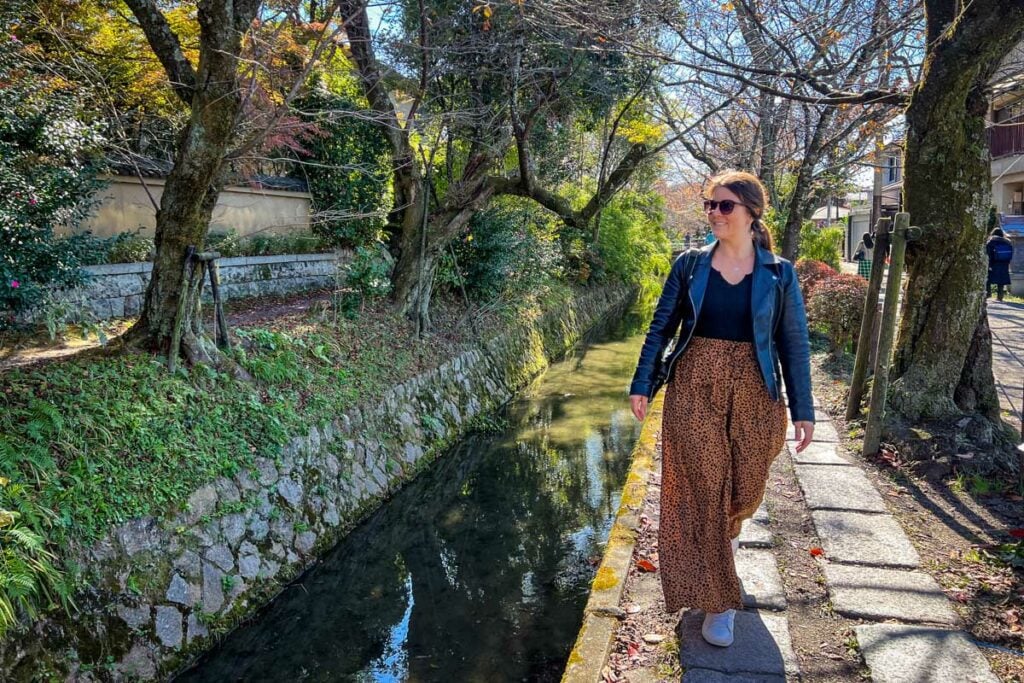
Japan is full of exciting activities and things to do, but trying to do and see everything can easily rack up your budget. Finding cheap—or better yet, free!—things to do in Japan is a great way to cut down on costs.
Here are just a handful of our favorite free/cheap experiences:
- Explore local markets
- Wander around parks
- People-watch on super busy streets
- Go to an arcade
- Try Purikura (Japanese photo booth)
- Explore historic districts
- Visit Shrines and temples
We have a whole section at the bottom of this article with more free and cheap things to do. Jump down to see the rest!
25. Choose your entertainment wisely

There are some tours and experiences that are well worth the splurge, whereas other activities can be done on your own without a tour group at all!
When planning your trip to Japan on a budget, write down all your bucket list experiences that you absolutely must do.
Now, go through that list and determine which things you can do on your own for less money than tour operators charge. And for those things that you absolutely have to book, like visiting the TeamLab Borderless Museum, Universal Studios, or doing the Alpine Route, write down the prices and keep that in mind as you create your travel budget.
Insider Tip: Compare prices of the same tour between Airbnb Experiences, Get Your Guide, and Klook. Sometimes tours are on just one platform, and other times they’re on all three, allowing you to choose the cheapest version.
It’s okay to have some splurges, as long as you are prepared for them.
Don’t let a small budget make it feel like you can’t do the experiences you’ve been dreaming about. Instead, cut costs in other places, like accommodation or food, to even it out.
26. Limit your shopping
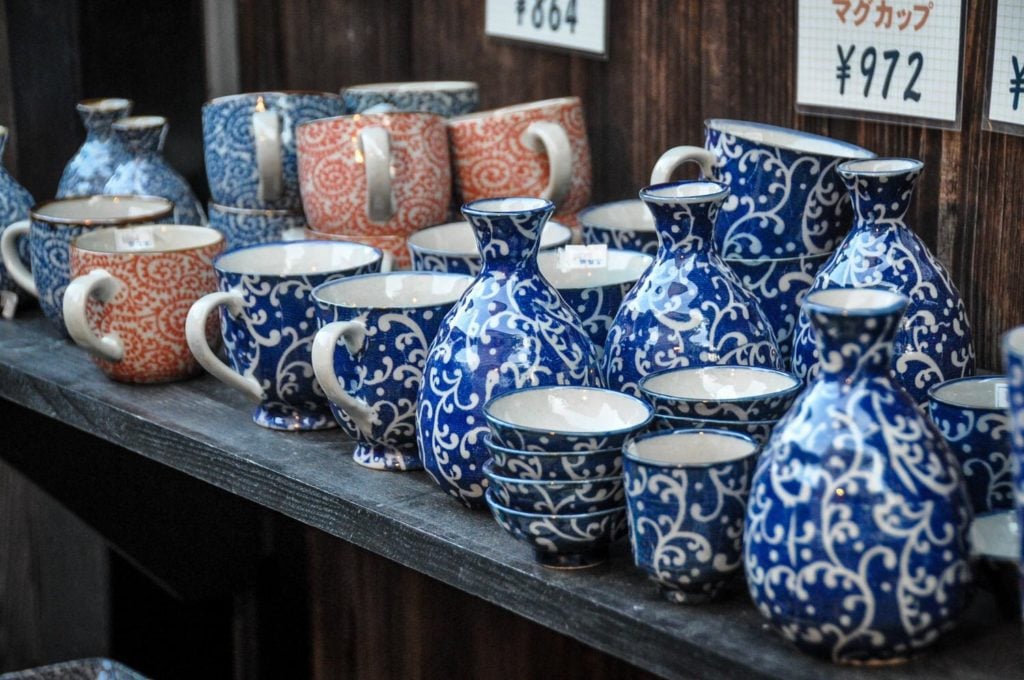
With endless shopping opportunities, it’s easy to get carried away. Before your trip, do some research and make a list of things you want to buy in Japan and include estimated prices.
Now comes the hard part: Stick to that list during your trip! If you stick to your pre-made list, you’ll make sure that you’re only purchasing things that are really meaningful or special. And you’ll stick to your budget!
Free (& cheap!) things to do in Japan
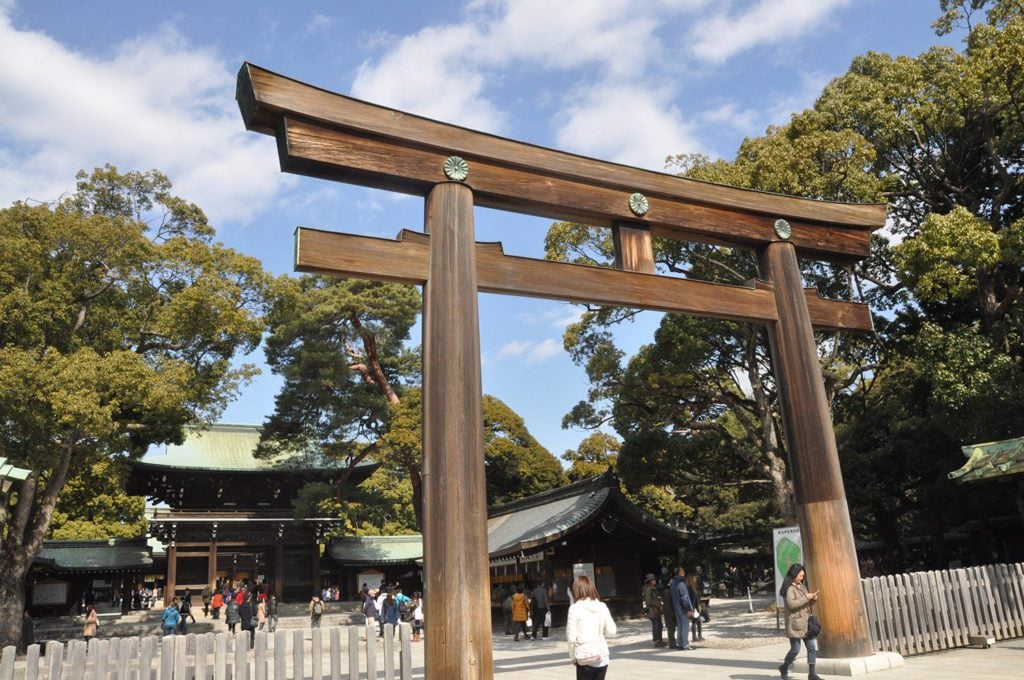
Japan is not the cheapest travel destination, but there are some free and inexpensive activities you can take advantage of to keep your wallet happy!
- Find a free walking tour: You’ll meet other travelers and learn stories and information that you’d never find out on your own! You can find walking tours in the bigger cities, like Kyoto Free Walking Tour, Osaka Free Walking Tour and Tokyo Free Walking Tour.
- Visiting shrines and temples: Many temples and shrines in Japan are free to enter and explore. For example, Meiji Shrine, which is not far from Tokyo. Just be sure to read up on the etiquette for visiting before you go!
- Explore historic districts: Wander on foot through the historic districts of the various cities/towns you visit in Japan and get a sense of the history of the place—all without paying a dime (or should we say yen!).
- Parks: There are tons of free parks throughout Japan, including Minoo Park outside of Osaka and Arashiyama bamboo grove in Kyoto.
- Join a Meetup: There are plenty of meet up groups that you can find online. Simply Google “Meetups in [your city].” Here is the Meetup site for Tokyo.
- Explore the markets: There are thousands of markets all throughout Japan. You can’t miss the Tsukiji Fish Market in Tokyo or the Nishiki Market in Kyoto. We also love the walking street/restaurant haven in the Dotonbori neighborhood of Osaka.
- Go to an arcade: Japan has lots of arcades in major cities where you can enter for free and pay a few coins to play games. Be sure to try Pachinko, Japan’s glammed-up version of pinball. We have instructions in our article here.
- Try Purikura: These Japanese photo booths are a quick and fun experience and a great way to bring home a cheap souvenir!
Plan your trip to Japan
After 3 trips (and counting!), we’ve fallen head over heels for Japan—and we’ve gathered TONS of resources to help you plan your dream trip. Start with our Ultimate Japan Travel Guide and be sure to check out these helpful articles:
- First time? Our Japan Trip Planner walks you through everything you need to know.
- Use our Japan Rail Pass guide to determine if getting a train pass is optimal for your trip.
- Here’s our curated list of the best things to do in Japan—from iconic sights to once-in-a-lifetime experiences.
- Not sure where to go? Our Japan itinerary ideas will help you map it all out.
- Foodies, rejoice! This guide to what to eat in Japan will have you drooling before you land.
- This guide to what to wear in Japan (and what not to wear) will help you blend in.
- Use our ultimate Japan Packing List to make sure you don’t forget anything.
- Before you go, brush up on these essential Japan travel tips (including major do’s and don’ts!).
- Avoid awkward moments by brushing up on Japanese etiquette.
Still have questions? Drop us a comment—we LOVE helping travelers plan unforgettable trips to Japan!
Perfect Japan itinerary
Want the perfect itinerary planned for you?

If you don’t have a ton of time to spend planning your Japan itinerary (or you just don’t find travel planning fun), we’ve got something you might be interested in…
We created the ultimate done-for-you Japan itinerary that is packed full of all sorts of tips we’ve gathered from 3 trips to Japan as well as literally hundreds of hours of research (no exaggeration).
We have both an off-the-beaten path route as well as a classic itinerary that hits the top attractions (perfect for your first visit to Japan!).
Don’t miss your chance to grab our Japan packing list!
This FREE PDF download includes everything you’re going to want to pack for your Japan trip, including what NOT to bring, plus tons of insider tips!
Just enter your email and we’ll immediately send you access instructions!
Save this article on Pinterest for later!
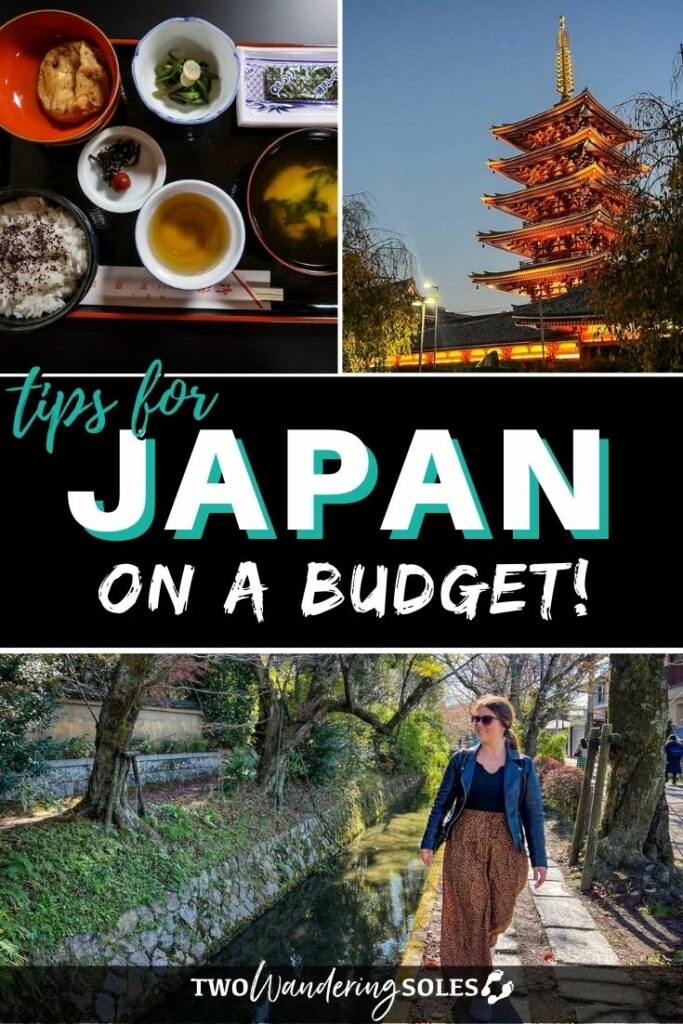
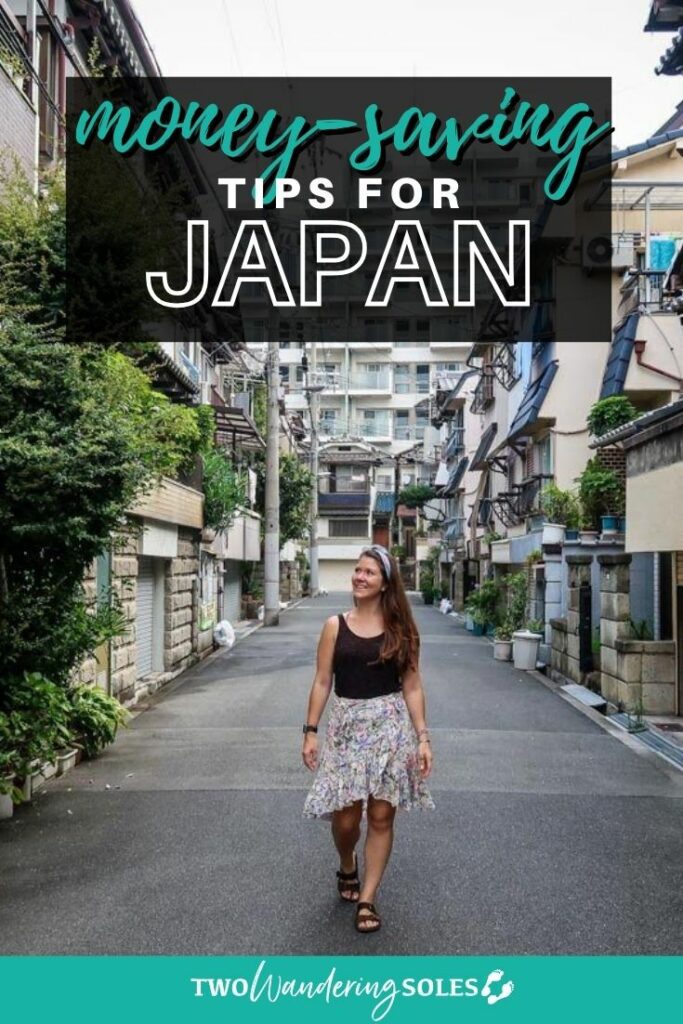
We want to hear from you!
Which of these money-saving tips for traveling Japan on a budget do you think will be the most helpful? Do you have any more budget tips you think we should add to this list? Comment below and we’ll do our best to get back to you!

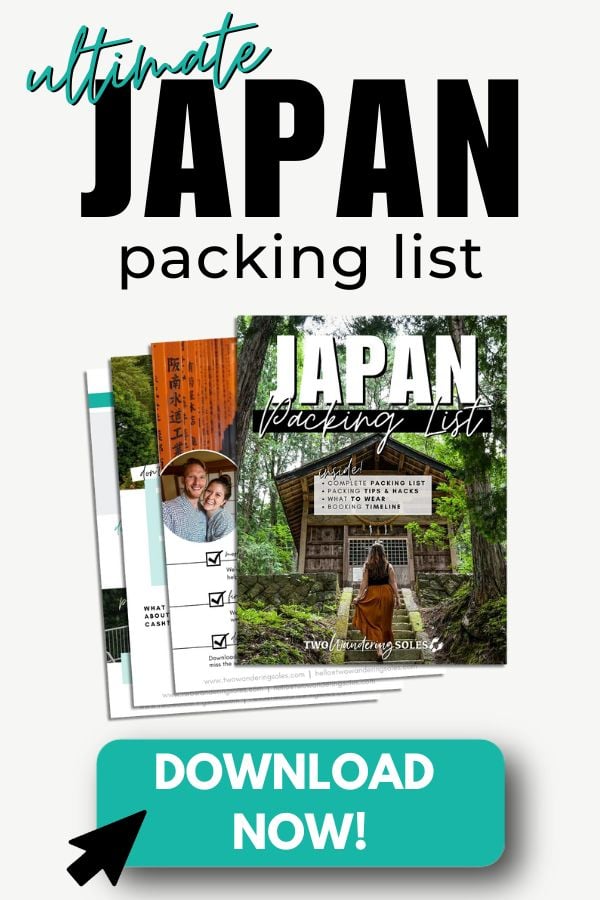
I Really appreciate your work! I read your article and discovered something new, so keep up the great work. Thanks for sharing!
Nice Work, Keep It Up.
I read your article so good , thanks for share
Golden Triangle Tours offers the best-selling Golden Triangle tour packages in India. Come and discover these incredible cities of India with our carefully planned and custom-tailored packages.
I Appreciate your work, I read your article and found something new here keep it up and, Thanks for sharing this.